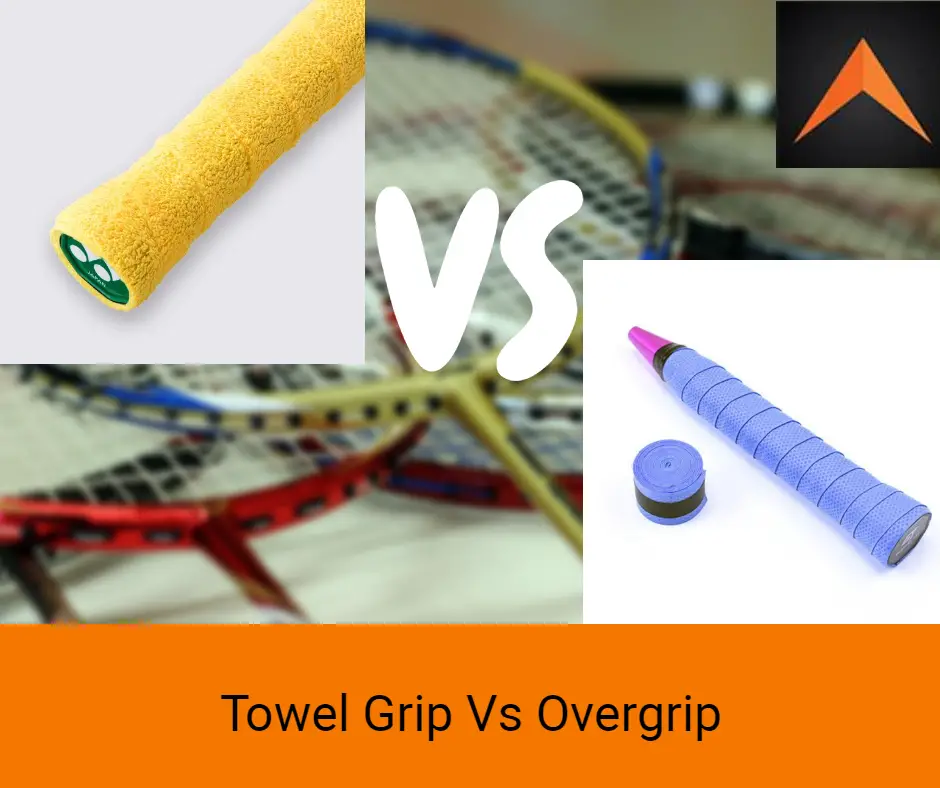Towel grip vs. Overgrip: which is better?
The question that many people ask themselves is whether to use a towel grip or an over grip. The answer is, it depends.
A towel grip will be more absorbent than a rubber grip or overgrip, which means that the fibers will dry faster.
The second factor to consider is the material from which the grip is made.
A towel grip will obviously be more absorbent than an overgrip, so if you sweat a lot or play in humid conditions, a towel grip might be a better option.
A good example of this would be how well a towel can handle water when it rains or how well it dries when it’s dry for at least two days before drying off.
Some players also prefer using a strict overgrip because they feel that their strokes are more consistent and accurate as they wear it in — this can be very useful if you want to play with your family and friends who are not badminton players.
If you want something to keep your hand from slipping around on the shuttlecock, then look for towels with thumb holes that prevent this from happening. They are both less expensive and easier to get hold of than other materials such as cork and rubber bands which can cause problems if they cause friction between your hand and shuttlecock during play.
There are three factors to consider when choosing between towels with thumb holes and non-thumb-hole towels: absorbency (the more absorbent the material is), material (how much moisture it can take up) and thumb hole preference (if you want some extra protection without having so many thumb holes).

Factors to consider when choosing between a towel grip and overgrip:
Factors to consider when choosing between a towel grip and overgrip for badminton:
Towel grip – Pros:
Less expensive, easy to apply, more comfortable when the weather is warm
Towel grip – Cons:
Less durable, hard to adjust, tends to slip more because it is not as smooth
Overgrip – Pros:
More durable, stays in place better because they are manufactured with a coarse texture and grip liner
Overgrip – Cons:
Harder to apply (usually need a sticky spray or rubber gloves), more expensive
What are the benefits of using a towel grip?
While there are many benefits to using a towel grip, the most obvious benefit is absorbency. As you’ll see in the example below, in wet conditions a towel grip will outperform an overgrip.
In dry conditions, however, the absorbency may not be as noticeable. For this reason alone, I would consider overgrips to be better options.
At the end of the day, both forms of gripping have their respective pros and cons. Decide what you’re comfortable with and make your choice accordingly.
What are the benefits of using an overgrip?
Badminton grip is an important part of the game. It’s one of the few things that can be used over and over and will give you a great advantage in your game. Overgrips are generally considered to be inferior to towel grips, but that’s only because they are not very absorbent. The difference is not big enough to make a significant difference in your game, so there’s no need to spend a lot of money on them.
How to decide which type of grip is best for you:
Some people like their grips to feel smooth, while others like their grips to feel firm. The good news is that there are a lot of different ways you can grip your badminton racket.
Grip is a very personal thing. You may have a particular way of gripping your racket that feels best for you, so it’s worth going into the specifics of how each grip feels on your hands and body.
I like my grip to be firm for two reasons:
1) it helps me get a better start when I’m hitting my shots and
2) it keeps the racquet from slipping out of my hand as I swing my arms.
My overgrips give me more of an opportunity to adjust my technique, which is what I need to do in order to get good scores on every shot I take.
One of the problems with most badminton grips is that they are made out of synthetic materials, which aren’t great for absorbing sweat or moisture, so I try and find grips with natural materials whenever possible.
A few things to keep in mind when buying your overgrip:
1.) The bigger size means less weight on your hands (more efficient use of racquet weight). Essentially, the more weight you have on your racket, the more likely you are to lose control in the middle portion of a point where contact is needed for a good stroke. So go for something that will help you maximize your points; overgrips tend to work better with heavier racquets because they help you keep control better at these important points (e.g., when you hit a shot or take an unexpected spin) .
2.) If you are using a towel grip, make sure it fits snugly around your hand (especially if you play singles or doubles). This helps prevent sweaty palms! It also makes it easier for beginners who don’t yet know how to play tightly around their wrist (especially women who often have smaller wrists than men).
3.) If playing doubles or singles, make sure that the grip doesn’t slip down easily between points because this can negatively impact shots such as forehand/backhand volleys and strokes where one hand must push against an opponent while they are attempting an attack (e.g., backhand serves). If this happens often enough, wearers will eventually lose control and probably lose points as well .
4.) You want something that fits comfortably
The reason for this is that there are various factors that influence the playing conditions:
(1) towel grip type (overgrip vs badminton grip)
(2) playing surface (dirt, grass, clay, mud)
(3) players’ physical condition and body composition (fatigue, muscle imbalance),
(4) wetness (waterlogged, dripped on), and
(5) atmospheric conditions (humidity).
In fact, towel grips are more commonly used by newer players who prefer them due to their more compact shape and compact size which allows more power with less space. The overgrip is typically used by experienced players who want a little more comfort while still being able to utilize all the power of their racquet.
As an experienced player or coach you should always be aware of the playing conditions you are in so as not to do harm to your body through an inconsistent playing technique or poor playing conditions such as waterlogged pitches.
– other factors to consider
The positive aspects of the overgrips are a smoother swing, less pressure on the wrist, more control and less strain on the wrist. The negative aspects are that they are more difficult to use, require a higher level of hand dexterity and they put too much pressure on the wrist joint. Although most badminton players who have tried both grips find that they prefer one or the other.
The overgrip is ideal when your hands are sweaty or when you play in humid conditions. If your hands sweat in such conditions then it is more likely that you will use an overgrip rather than a towel grip.




